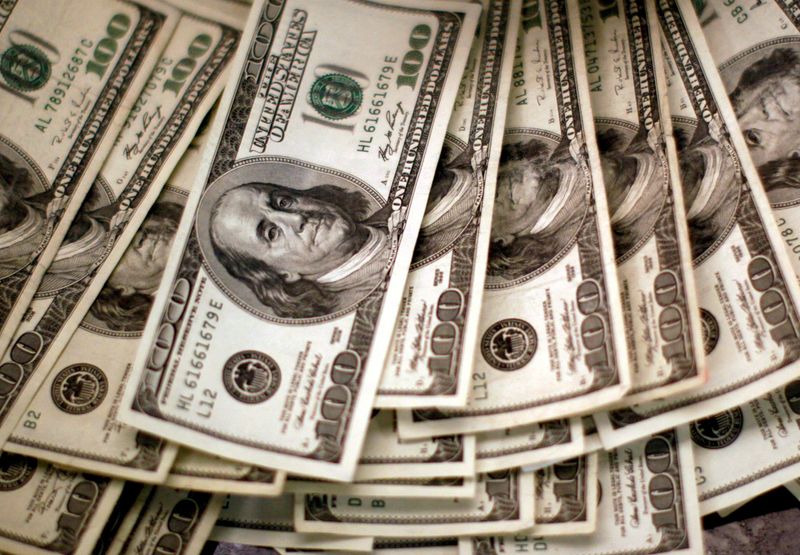Forex
Dollar bounces from 15-month low on strong core U.S. retail sales


© Reuters. FILE PHOTO: U.S. dollars are counted out by a banker counting currency at a bank in Westminster, Colorado November 3, 2009. REUTERS/Rick Wilking/File Photo
By Karen Brettell
NEW YORK (Reuters) – The U.S. dollar rose from a 15-month low against a basket of currencies on Tuesday after core retail sales saw strong gains in June, as investors wait on the Federal Reserve’s interest rate decision next week.
Headline U.S. retail sales rose less than expected in June, with a 0.2% increase during the month. Data for May was also revised higher to show sales gaining 0.5% instead of 0.3% as previously reported.
Core sales showed more resilience, however. Excluding automobiles, gasoline, building materials and food services, retail sales increased 0.6% in June. Data for May was revised slightly up to show core retail sales increasing 0.3% instead of the previously reported 0.2%.
The softer-than-expected headline number suggests that “the Fed is making some progress,” said Bipan Rai, North American head of FX strategy at CIBC Capital Markets in Toronto.
However, “you still did get a fairly strong control group number – that’s going to feed through to GDP and domestic demand. That’s still very much supportive of the fact that the Fed does need to hike rates again later this month,” Rai said.
The dollar tumbled after consumer and producer price gains slowed in June, boosting expectations that the U.S. central bank will stop hiking rates after a widely expected 25 basis-point increase at its July 25-26 meeting.
Fed funds futures traders are pricing in an additional 33 basis points of tightening this year, with the benchmark rate expected to peak at 5.40% in November.
Other data on Tuesday showed production at U.S. factories unexpectedly fell in June, but rebounded in the second quarter as motor vehicle output accelerated after two straight quarterly declines.
Traders will also be watching inflation releases from regions including the eurozone, Britain and Japan this week for further clues about whether inflation is cooling globally.
The was last up 0.04% on the day at 99.924, after earlier falling to 99.549, the lowest since April 2022.
Bank of America (NYSE:) analysts noted in a report on Tuesday that recent weakness in the greenback has exceeded the drivers of the move, which “can typically be attributed to stretched positioning and sentiment, as well as technical breaks.”
In particular the analysts note that gains in the Norwegian krone and Japanese yen have exceeded their expected moves, and that they expect yen underperformance to resume “once the dust settles.”
The dollar rose 0.10% against the Japanese yen to 138.83, after dropping to 137.245 on Friday, the lowest since May 17.
The euro was little changed on the day at $1.1229 after earlier hitting $1.12760, the highest since Feb. 2022.
European Central Bank (ECB) governing council member Klaas Knot said on Tuesday that the bank will look closely for signs of inflation cooling down in the coming months to avoid taking rate hikes too far.
The European Central Bank is expected to raise interest rates by 25 basis points next week.
The British pound fell 0.22% to $1.3046, after hitting $1.31440 on Thursday, the highest since April 2022.
The Australian dollar fell 0.07% to $0.6813 after minutes of the Reserve Bank of Australia’s (RBA) July policy meeting released on Tuesday provided no major surprises on the rate outlook.
========================================================
Currency bid prices at 3:00PM (1900 GMT)
Description RIC Last U.S. Close Pct Change YTD Pct High Bid Low Bid
Previous Change
Session
Dollar index 99.9240 99.9030 +0.04% -3.446% +100.1000 +99.5490
Euro/Dollar $1.1229 $1.1228 +0.01% +4.80% +$1.1276 +$1.1209
Dollar/Yen 138.8300 138.6950 +0.10% +5.89% +139.1300 +137.6900
Euro/Yen 155.88 155.86 +0.01% +11.10% +156.1400 +154.8800
Dollar/Swiss 0.8574 0.8603 -0.33% -7.27% +0.8607 +0.8556
Sterling/Dollar $1.3046 $1.3074 -0.22% +7.87% +$1.3125 +$1.3029
Dollar/Canadian 1.3174 1.3199 -0.19% -2.77% +1.3243 +1.3168
Aussie/Dollar $0.6813 $0.6817 -0.07% -0.07% +$0.6837 +$0.6789
Euro/Swiss 0.9625 0.9668 -0.44% -2.73% +0.9672 +0.9626
Euro/Sterling 0.8607 0.8589 +0.21% -2.68% +0.8608 +0.8578
NZ $0.6280 $0.6326 -0.72% -1.09% +$0.6344 +$0.6261
Dollar/Dollar
Dollar/Norway 10.0470 10.0240 +0.33% +2.48% +10.1150 +10.0400
Euro/Norway 11.2816 11.2868 -0.05% +7.51% +11.3600 +11.2752
Dollar/Sweden 10.2108 10.2468 -0.47% -1.89% +10.2678 +10.1716
Euro/Sweden 11.4590 11.5129 -0.47% +2.78% +11.5434 +11.4469

 Forex3 years ago
Forex3 years agoForex Today: the dollar is gaining strength amid gloomy sentiment at the start of the Fed’s week

 Forex3 years ago
Forex3 years agoUnbiased review of Pocket Option broker

 Forex3 years ago
Forex3 years agoDollar to pound sterling exchange rate today: Pound plummeted to its lowest since 1985

 Forex3 years ago
Forex3 years agoHow is the Australian dollar doing today?

 Cryptocurrency3 years ago
Cryptocurrency3 years agoWhat happened in the crypto market – current events today

 World3 years ago
World3 years agoWhy are modern video games an art form?

 Commodities3 years ago
Commodities3 years agoCopper continues to fall in price on expectations of lower demand in China

 Economy3 years ago
Economy3 years agoCrude oil tankers double in price due to EU anti-Russian sanctions





















